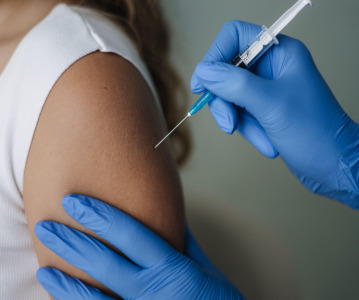Eylea outperforms Avastin for diabetic macular edema with moderate or worse vision loss

NIH-funded clinical trial shows Eylea, Avastin, and Lucentis perform similarly when vision loss is mild.
A 2-year clinical trial that compared three drugs for diabetic macular edema (DME) found that gains in vision were greater for participants receiving the drug Eylea (aflibercept) than for those receiving Avastin (bevacizumab), but only among participants starting treatment with 20/50 or worse vision. Gains after 2 years were about the same for Eylea and Lucentis (ranibizumab), contrary to year-one results from the study, which showed Eylea with a clear advantage. The three drugs yielded similar gains in vision for patients with 20/32 or 20/40 vision at the start of treatment. The clinical trial was conducted by the Diabetic Retinopathy Clinical Research Network, which is funded by the National Eye Institute, part of the National Institutes of Health.
“This rigorous trial confirms that Eylea, Avastin, and Lucentis are all effective treatments for diabetic macular edema,” said NEI Director Paul A. Sieving. “Eye care providers and patients can have confidence in all three drugs.”
Eylea, Avastin, and Lucentis are all widely used to treat DME, a consequence of diabetes that can cause blurring of central vision due to the leakage of fluid from abnormal blood vessels in the retina. The drugs are injected into the eye and work by inhibiting vascular endothelial growth factor (VEGF), a substance that can promote abnormal blood vessel growth and leakage. Although the drugs have a similar mode of action, they differ significantly in cost. Based on Medicare allowable charges, the per-injection costs of each drug at the doses used in this study were about $1850 for Eylea, about $60 for Avastin, and about $1200 for Lucentis.
DRCR.net investigators enrolled 660 people with DME at 89 clinical trial sites across the US. When the study began, participants on average were 61 years old with 17 years of type 1 or type 2 diabetes. Only people with a visual acuity of 20/32 or worse were eligible to participate (to see clearly, a person with 20/32 vision would have to be 20 feet away from an object that a person with normal vision could see clearly at 32 feet). At enrollment, about half the participants had 20/32 to 20/40 vision. The other half had 20/50 or worse vision. In many states, a corrected visual acuity of 20/40 or better in at least one eye is required for a driver’s license that allows both day- and nighttime driving.
Each participant was assigned randomly to receive Eylea (2.0 mg/0.05 mL), Avastin (1.25 mg/0.05 mL), or Lucentis (0.3 mg/0.05 mL). Participants were evaluated monthly during the first year and every 4–16 weeks during the second year. Most participants received monthly injections during the first 6 months. Thereafter, participants received additional injections of assigned study drug until DME resolved or stabilized with no further vision improvement. Subsequently, injections were resumed if DME worsened. Additionally, laser treatment was given if DME persisted without continual improvement after 6 months of injections. Laser treatment alone was the standard treatment for DME until widespread adoption of anti-VEGF drugs a few years ago.
Among participants with 20/40 or better vision at the trial’s start, all three drugs improved vision similarly on an eye chart. On average, participants’ vision improved from 20/40 vision to 20/25.
Among participants with 20/50 or worse vision at the trial’s start, visual acuity on average improved substantially in all three groups. At 2 years, Eylea participants were able to read about 3.5 additional lines on an eye chart; Lucentis participants were able to read about three additional lines, and Avastin participants improved about 2.5 lines, compared with visual acuity before treatment. Eylea outperformed Avastin at the 1- and 2-year time points. While Eylea outperformed Lucentis at the one-year time point, by the two-year time point gains in visual acuity were statistically no different. At the end of the trial, average visual acuity was 20/32 to 20/40 among participants in all three groups.
“The results of the DRCR Network’s comparison of Eylea, Avastin, and Lucentis will help doctors and their patients with diabetic macular edema choose the most appropriate therapy,” said John A. Wells, the lead author of the study and a retinal specialist at the Palmetto Retina Center, Columbia, South Carolina. “The study suggests there is little advantage of choosing Eylea or Lucentis over Avastin when a patient’s loss of visual acuity from macular edema is mild, meaning a visual acuity of 20/40 or better. However, patients with 20/50 or worse vision loss may benefit from Eylea, which over the course of the 2-year study outperformed Lucentis and Avastin.”
The number of injections participants needed was about the same for all three treatment groups. Eylea, Avastin, and Lucentis participants on average required nine injections in the first year of the study and five in the second year.
The need for laser treatment varied among the three treatment groups. By 2 years, 41% of participants in the Eylea group received laser treatment to treat their macular edema, compared with 64% of participants in the Avastin group and 52% in the Lucentis group.
“This important study would not have happened without funding from the National Institutes of Health and the cooperation of two competing companies,” said Adam R. Glassman, principal investigator of the DRCR.Net Coordinating Center at the Jaeb Center for Health Research.Related News
-
News A Day in the Life of a Start-Up Founder and CEO
At CPHI we work to support Start-Up companies in the pharmaceutical industry and recognise the expertise and innovative angles they bring to the field. Through our Start-Up Programme we have gotten to know some of these leaders, and in this Day in the ... -
News Biopharmaceutical manufacturing boost part of new UK government budget
In their national budget announced by the UK Labour Party, biopharmaceutical production and manufacturing are set to receive a significant boost in capital grants through the Life Sciences Innovative Manufacturing Fund (LSIMF). -
News CPHI Podcast Series: The power of proteins in antibody drug development
In the latest episode of the CPHI Podcast Series, Lucy Chard is joined by Thomas Cornell from Abzena to discuss protein engineering for drug design and development. -
News Amgen sues Samsung biologics unit over biosimilar for bone disease
Samsung Bioepis, the biologics unit of Samsung, has been issued a lawsuit brought forth by Amgen over proposed biosimilars of Amgen’s bone drugs Prolia and Xgeva. -
News CPHI Podcast Series: Why we need to consider women in clinical trials
The latest episode of the CPHI Podcast Series with Lucy Chard covers women's health, specifically women's representation in clinical trials, the associated bias, and the impacts on health for this population. -
News US FDA does not approve MDMA therapy for PTSD, requests more data
The MDMA-based therapeutic developed by Lykos Therapeutics, a California-based Public Benefit Corporation (PBC), has been reviewed and unapproved by the US FDA. The regulator has requested additional phase III trial data for further safety and efficacy... -
News Novartis and Viatris latest facing lawsuit over HeLa cell misuse
Global pharmaceutical companies Novartis and Viatris are the latest hit with a lawsuit claim pertaining to alleged misuse of the ‘HeLa’ cell line from the estate of woman whose cancerous tissue cells were taken without consent. -
News Sanofi invests billions into Frankfurt insulin production site
French pharmaceutical company Sanofi have announced an investment of EUR1.3 billion at their existing BioCampus site in Frankfurt am Main for the expansion of insulin production.
Position your company at the heart of the global Pharma industry with a CPHI Online membership
-
Your products and solutions visible to thousands of visitors within the largest Pharma marketplace
-
Generate high-quality, engaged leads for your business, all year round
-
Promote your business as the industry’s thought-leader by hosting your reports, brochures and videos within your profile
-
Your company’s profile boosted at all participating CPHI events
-
An easy-to-use platform with a detailed dashboard showing your leads and performance



.png)

.png)
.png)
.png)